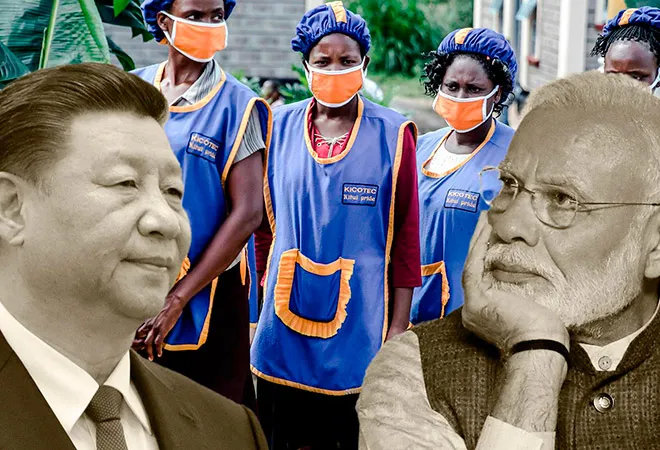The COVID-19 pandemic has been a great leveller across the world. But its effects stand to be devastating particularly in Africa, where economic and public health conditions are extremely vulnerable. Although African countries moved quickly to curb the initial spread, they are still woefully ill-equipped to cope with a public health emergency of such magnitude due to shortages of masks, ventilators, and even basic necessities such as soap and water. Such conditions have meant that Africa’s cycle of chronic external aid dependence continues. Africa needs medical protective equipment and gear to support its front line public health workers. As Asia’s two largest economies and long-standing partners of Africa, India and China have increased their outreach to Africa through medical assistance. Their efforts are directed to fill a part of the growing African need at a time when not many others have stepped in to help.
Beijing’s donation diplomacy
China, being Africa’s largest trading partner, was quick to signal its intent to help Africa cope with the pandemic. It despatched medical protective equipment, testing kits, ventilators, and medical masks to several African countries. The primary motive of such donations has been to raise Beijing’s profile as a leading provider of humanitarian assistance and “public goods” in the global public health sector. China’s billionaire philanthropy was also in full display when tech founder Jack Ma donated three rounds of anti-coronavirus supplies. These consignments were transported mostly by Ethiopian aircraft. Chinese embassies across Africa have taken the lead by coordinating both public and private donations to local stakeholders and have also embarked on a donation blitz of cash even as the sub-optimal quality of China’s medical supplies and its deputing of medical experts have been a major cause for concern.
Beijing’s ‘donation diplomacy’ in Africa aims to achieve three immediate objectives: shift the focus away from talking about the origins of the virus in Wuhan, build goodwill overseas, and establish an image makeover. For the most part, it succeeded in achieving these ends until China faced widespread backlash over the ill-treatment of African nationals in Guangzhou city. The issue quickly grew into a full-blown political crisis for Beijing. But for the most part, China has been successful in controlling the Guangzhou narrative due to the depth of its political influence in Africa. It is no secret that China relies heavily on diplomatic support and cooperation from African countries on key issues in multilateral fora. For example, Beijing used African support for securing a win for Chinese candidates as the head of Food and Agriculture Organization (FAO) and in the World Health Organization (WHO). On Africa’s part, the problem lies in the deep disjuncture and credibility gap between Africa’s governing class, the people, the media and civil society. Even when criticisms have been levelled against Chinese indiscretions, it has hardly ever surfaced at the elite level. Overall, China’s donation diplomacy towards Africa during COVID-19 has received mixed reactions, but Beijing’s advantage lies in its economic heft and political influence in Africa.
New Delhi’s focus
For India, the pandemic presents an opportunity to demonstrate its willingness and capacity to shoulder more responsibility. The fact that even with limited resources, India can fight the virus at home while reaching out to developing countries in need is testament to India’s status as a responsible and reliable global stakeholder. Nowhere has India’s developmental outreach been more evident than in Africa with the continent occupying a central place in Indian government’s foreign and economic policy in the last six years. Africa has been the focus of India’s development assistance and also diplomatic outreach, as evident in plans to open 18 new embassies. These efforts have been supplemented by an improved record of Indian project implementation in Africa.
India’s role as ‘the pharmacy of the world’, as the supplier of low-cost, generic medicines is widely acknowledged. Pharmaceutical products along with refined petroleum products account for 40% of India’s total exports to African markets. India is sending consignments of essential medicines, including hydroxychloroquine (HCQ) and paracetamol, to 25 African countries in addition to doctors and paramedics at a total cost of around ₹600 million ($7.9 million) on a commercial and grant basis. The initial beneficiaries were the African Indian Ocean island nations of Mauritius, the Seychelles, Comoros, and Madagascar under India’s ‘Mission Sagar’. While transportation and logistics remain a concern, most of the consignments have already reached various African states.
A timely initiative has been the e-ITEC COVID-19 management strategies training webinars exclusively aimed at training health-care professionals from Africa and the South Asian Association for Regional Cooperation (SAARC) nations and sharing of best practices by Indian health experts. Nigeria, Kenya, Mauritius, and Namibia have been beneficiaries. Across Africa, there is a keen interest to understand the developments and best practices in India because the two share similar socioeconomic and developmental challenges. There is also growing interest in research and development in drugs and vaccines. A few African countries such as Mauritius are pushing for health-care partnerships in traditional medicines and Ayurveda for boosting immunity. The Indian community, especially in East African countries, has also been playing a crucial role in helping spread awareness. Prominent Indian businessmen and companies in Nigeria and Kenya have donated money to the respective national emergency response funds. Country-specific chapters of gurdwaras and temples have fed thousands of families by setting up community kitchens, helplines for seniors and distributing disinfectants and sanitisers.
The contrasts
Both India and China, through their respective health and donation diplomacy, are vying to carve a space and position for themselves as reliable partners of Africa in its time of need. Burnishing their credentials as humanitarian champions is the name of the game. But there are significant differences in the approaches. For China, three aspects are critical: money, political influence and elite level wealth creation; strong state-to-state relations as opposed to people-to-people ties; and hard-infrastructure projects and resource extraction. India’s approach on the other hand is one that focuses on building local capacities and an equal partnership with Africans and not merely with African elites concerned. As these two powers rise in Africa, their two distinct models will come under even greater scrutiny. And both New Delhi and Beijing might find that they need to adapt to the rising aspirations of the African continent.
This commentary originally appeared in The Hindu.
The views expressed above belong to the author(s). ORF research and analyses now available on Telegram! Click here to access our curated content — blogs, longforms and interviews.




 PREV
PREV



